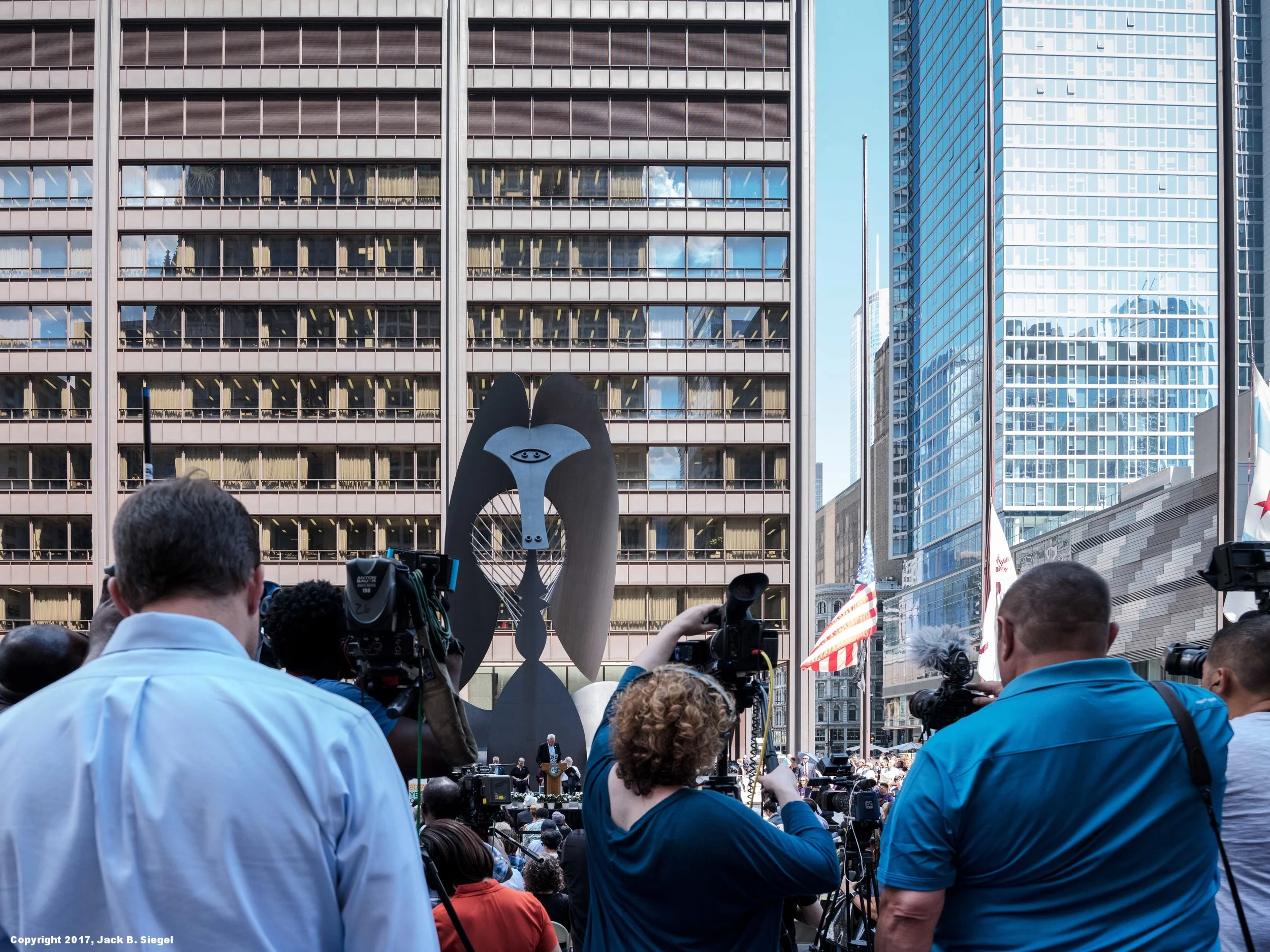Reenacting the Picasso Unveiling
Today, the City's Department of Cultural Affairs and Special Events held a reenactment of the August 15, 1967 unveiling of the Picasso statue that sits in Daley Plaza. Although a major tourist attraction, as well is should be, Anish Kapoor's Cloud Gate has usurped the Picasso's stature with city residents and visitors. Personally, I prefer the Picasso, which includes many classic Picasso motifs folded into its Cor-Ten steel outline and shapes.
The statue was a bold move on the part of then Mayor Richard J. Daley, who could hardly be viewed as a revolutionary. Ward bosses are rarely revolutionaries. In 1963, Chicago architect William E. Hartman (Skidmore, Owens) traveled to the southern France town of Mougin as part of an effort to convince Picasso to create a public sculpture for the plaza outside the to-be-constructed Daley Center. Picasso created a maquette for the fabricators, which can be seen at the Art Institute of Chicago. The resulting structure comes in at 162 tons and rises 50 feet above the plaza. It was fabricated by the American Bridge division of U.S. Steel in Gary, Indiana.
According to the Chicago Tribune, Hartman brought a Sioux war bonnet, a White Sox blazer, and a check for $100,000 from the Public Building Commission. It worked. Picasso, who had never been to Chicago, created the design free of charge. He refused the $100,000 fee and he refused to sign a Formal Acknowledgement and Receipt.
Today's event was billed as "Everyone's Picasso," but in keeping with the Chicago Way, that was not always the case. When Letter Edged in Black Press tried to sell photographs of the structure, the City demanded a licensing fee. It took a federal court determination to resolve the dispute, with the court holding that Picasso had donated the work to the People of Chicago, not to the Public Building Commission. As a consequence, any copyright in the statue had passed into the public domain. See, The Letter Edged In Black Press, Inc. v. Public Building Commission of Chicago, 320 F. Supp. 1303 (D.C. N.D. Ill. 1970).
The statue was revolutionary. Up until then, public artwork typically meant a man sitting on a horse, or a solider holding a rifle. Mayor Daley, who was not known for his eloquence, did a nice job of putting the work in perspective, stating, "We dedicate this celebrated work this morning with the belief that what is strange to us today will be familiar tomorrow." The Picasso is the first in a long line of public artworks that veer from traditional representational, historical statues and sculptures. In that line are works by Magdalena Abakanowicz (Michigan and Roosevelt in Grant Park); Marc Chagall (Dearborn and Monroe in the Chase Tower Plaza); Alexander Calder (Dearborn and Adams in the Federal Center Plaza); Ellsworth Kelly (Lincoln Park across from the Peggy Notebaert Nature Museum); Jean Dubuffet (100 West Randolph); Jacob Lawrence (Harold Washington Library); Sol LeWitt (10 W. Jackson Blvd); Joan Miro (69 West Washington Street); Henry Moore (Art Institute of Chicago Memorial Court and University of Chicago); Louise Nevelson (200 West Madison); Claus Oldenberg (600 West Madison); Jaume Plensa (Millennium Park); and Richard Serra (Grant Park). For more information on these and other works, see the Chicago Public Art Guide produced by the Department of Cultural Affairs and Special Events.
In attempting to recreate the original unveiling, the City claims that it replicated the original program by providing comparable speakers and performers to those who were there on August 15, 2017. I was happy to see Orbert Davis and Tatsu Aoki, two seminal Chicago jazz musicians. I could have done without the children's choir and the children's orchestra, as well as many of the speakers. I doubt whether the original unveiling ran on for 90 minutes, as did yesterday's festivities. It didn't help that the speaker system failed for long periods of time. Nor did the loudmouth protester who had a deep and sonorous voice that he projected like an unmiked opera singer. I am all for free speech, as were the police, who did not try to shut the man down. Yet, there is a time and place for everything. He might have announced his presence before the event started, and then waited until its conclusion to start ranting again. A little civility and respect for others goes a long way.
The Big Miss: The photographs of the 1967 ceremony depict a dramatic unveiling, with the large tarp covering the work being pulled away at the critical moment. There was no tarp; only the statue itself bathed in mid-day light that quickly turned to shadow. In my book, that is not a reenactment.
In 1967, it was Everyone's Picasso. Somewhere between 25,000 and 50,000 people were present for the unveiling on that August day 50 years ago. Not today. As I noted, there were no more than 3,000 or so people present. I suspect many were office workers on their lunch hour, diving in and out of the proceedings.
The Slogan of the Day: "Everyone's Picasso"
Mayor Rahm Emanuel Sings the Praise of Public Art
A Protester Could Be Heard Above the Crowd
The Statue, with a Reflection of the Flag in the Background
Youthful Exuberance
One of About 3,000 People in the Crowd
The Media Was Out in Force
The Protester Up Close and Personal
Mayor Rahm Emanuel Up Close and Personal




